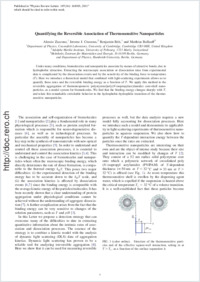Quantifying the reversible association of thermosensitive nanoparticles
- Zaccone, Alessio Department of Physics, Cavendish Laboratory, University of Cambridge, United Kingdom
- Crassous, Jérôme J. Adolphe Merkle Institute, University of Fribourg, Switzerland
- Béri, Benjamin Department of Physics, Cavendish Laboratory, University of Cambridge, United Kingdom
- Ballauff, Matthias Helmholtz Zentrum für Materialien und Energie, Berlin, Germany - Department of Physics, Humboldt-University, Berlin, Germany
-
11.10.2011
Published in:
- Physics Review Letters. - 2011, vol. 107, no. 16, p. 168303
English
Under many conditions, biomolecules and nanoparticles associate by means of attractive bonds, due to hydrophobic attraction. Extracting the microscopic association or dissociation rates from experimental data is complicated by the dissociation events and by the sensitivity of the binding force to temperature (T). Here we introduce a theoretical model that combined with light-scattering experiments allows us to quantify these rates and the reversible binding energy as a function of T. We apply this method to the reversible aggregation of thermoresponsive polystyrene/poly(N-isopropylacrylamide) core-shell nanoparticles, as a model system for biomolecules. We find that the binding energy changes sharply with T, and relate this remarkable switchable behavior to the hydrophobic-hydrophilic transition of the thermosensitive nanoparticles.
- Faculty
- Faculté des sciences et de médecine
- Department
- AMI - Soft Nanoscience
- Language
-
- English
- Classification
- Physics
- License
-
License undefined
- Identifiers
-
- RERO DOC 27388
- DOI 10.1103/PhysRevLett.107.168303
- Persistent URL
- https://folia.unifr.ch/unifr/documents/302007
Other files
Statistics
Document views: 104
File downloads:
- pdf: 167
- Supplementary material: 127

